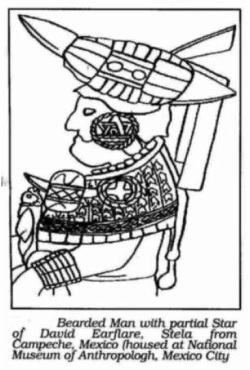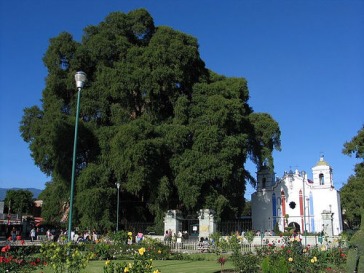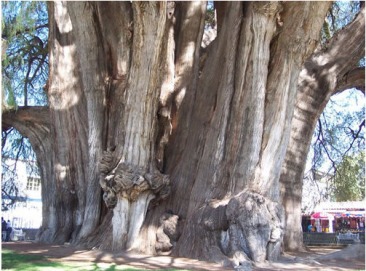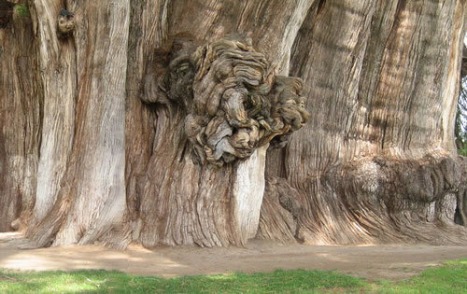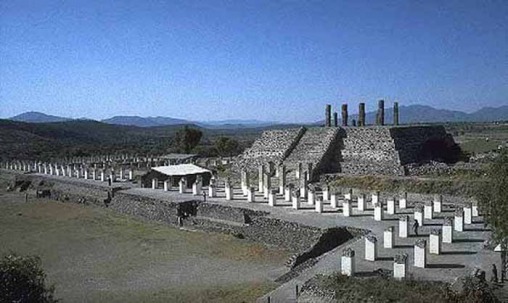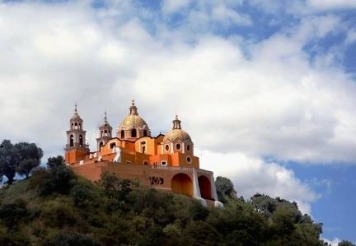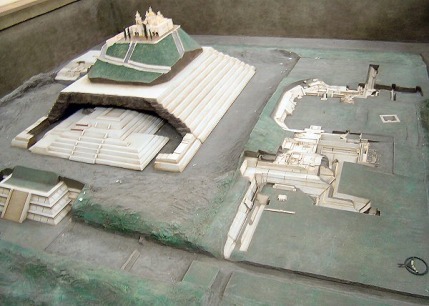Mexico
From, "The God of Wind and Water", pg. 31.......
When the Prophet visited Panuco along the shores of the Sunrise Ocean. Often He read their legends of ancient history and discussed them with the priesthood. "Well He knew the name 'Serpent' stood for the earth's sea-people who had once with their fleets ruled the oceans and established colonies on many shorelines. He knew that the word stood for water, even as did His first name Wako-Wah meaning water and Co for serpent. It was a tribute to His power over the ocean when at His command it had cleansed the temple at Pacha-camac."
"One of His favorite books was that ancient history which had come down to His time through many ages from the day when the Red Land (Atlantis), which had fathered the Serpents, their colonies and fleets of ocean -going vessels, went down in the fury of volcanic destruction into the cold green depths of the ocean."
"Proof that I am a Serpent" by the last remaining grandson to leave the doomed homeland, with its eyewitness description by the young prince from the House of Votan, was often read by the Prophet. Yet closing its pages, He warned the puzzled priesthood to copy it very often, sending it to many nations, so that one copy might escape the flames, for when He touched it, He saw its final destruction in a holocaust which turned it to ashes. (Note: It was burned by the conquering Spanish.)
"In the long forgotten ages the islands of the Serpents had been beset by another totem. These were the men of the Wind God. They twined feathers in their hair and shot with bows and arrows against the poisoned lances of the Serpent. Finally this ability to kill at a distance overcame the proud sea-kingdom already harassed by the Fire God which it worshiped and the victor was the Bird of The Lightnings, known around the world as the Condor. Lost in the silt of long dead ages was this time when the Condor fought the Serpent, yet the people of each land had never forgotten and the ancient hatred was everywhere faced by the Prophet.
"The land of Panuco, which shortened from the longer name of the Ancients means: "The place where the Serpents landed when they fled from burning Pahn."
From, "The Grove at Tule" pg. 143....
In the days of the Prophet there lived an aged cedar in the grove of Tule, Oaxaca and blessings to all, it still exists. "For time beyond the history of nations this tree has been an object of worship." This ancient cedar has lived through the trials of man with the air of wars, famine and great civilizations being born and passing on.
"Some said it was planted by Votan, with the seeds he brought from the Old Red Land which sank below the Sunrise Ocean." Hansen goes on to describe; "When Kate-Zahl first saw its massive proportions, He ordered a temple built near it and called it the "Tree of our Father", saying to people who gathered around Him: "Remember to protect this giant always, for it is the oldest thing that is living upon the entire face of our planet."
He used to lean against a younger cedar right next to it while the Zapotecas danced by the moonlight their Calendar Dance of the Feathers. The Zapotecas named the second tree the "Tree of the Pale Son." On rare occasions it is said, " a figure dressed in a long white toga with black crosses embroidered at the hem and hair like the misty pearl of the moonlight leans against the Tree of the Pale Son and raises his hand in benediction.
"(An Oaxaca Legend.)"
"Some said it was planted by Votan, with the seeds he brought from the Old Red Land which sank below the Sunrise Ocean." Hansen goes on to describe; "When Kate-Zahl first saw its massive proportions, He ordered a temple built near it and called it the "Tree of our Father", saying to people who gathered around Him: "Remember to protect this giant always, for it is the oldest thing that is living upon the entire face of our planet."
He used to lean against a younger cedar right next to it while the Zapotecas danced by the moonlight their Calendar Dance of the Feathers. The Zapotecas named the second tree the "Tree of the Pale Son." On rare occasions it is said, " a figure dressed in a long white toga with black crosses embroidered at the hem and hair like the misty pearl of the moonlight leans against the Tree of the Pale Son and raises his hand in benediction.
"(An Oaxaca Legend.)"
From, Tula The Golden, pg. 113.........
"Golden Tula, Capitol of Mighty Tollan. Immensely wealthy were the Toltecs. Slaves and jewels without number came through the mosaic gateways, resplendent in their pearl and emerald. Vast were their chocolate plantations; endless their orchards of various fruit trees; stout grew their amarinth stalks, their nuts and beverages most delicious and many other delicacies which today the Toltecs are lacking, being lost during the passage of the ages. As in the kingdoms of the Andes, cotton grew in all the colors of the rainbow and there was no need to dye it. So large were the Toltec corn-ears that it took a man to lift them and the kind which has come to us through the ages of war and pillage is but the scrub corn grown by the Toltecs to heat their baths of perfumed water.
Thousands of animals were bred by the Toltecs from deer and buffalo to coons and rabbits. They had large flocks of geese, turkeys and ducks. Of the features most remembered were the miles of fragrant parkways filled with the sound of splashing fountains and scents of exquisite flowers. Here the trees were filled with music with enclosures that were wire netted so thousands of birds whose liquid voices had been specially bred for untold generations there to enchant the listener.
Strangely skillful were the Toltecs in the fashioning of metals. Gold, silver, bronze and copper and the finest double plating was the art of their clever jewelers. Wealth unheard of was gathered in Tula. Palaces frescoed with pearls, edifices worked from coral, temples covered with the finest of gold work and edged with jade were among their wonders. Even their streets were paved with metal.
Such was the fabulous golden metropolis whose fame had spread through a thousand nations and whose sight lingered on in memory in uncounted legends for untold years after its fall and pillage. Such was the worlds most beautiful city when the Prophet came to Tula."
"(Partly from "Song of Quetzalcoatl", partly from Yaqui chant.)"
From, "Entrance Into Tula", pg. 115.....
"It is said that He paused on the passes gazing long upon the golden rooftops, glowing in the early morning sunrise like a frozen sea of lava glistening in copper gold eruption. From far beyond the outer ramparts stretched the homes of stucco, the edifices and markets of distant Tula. Some were built on the pyramid order, where one man's roof is another's garden. Usually they were filled with ferns and flowers, for the Toltecs loved their beauty and tinkling streams of tumbling water, which ran down a hard tiled stream-bed from roof to roof."
"Then at last He came to the Great Wall. There in black and orange, gray and crimson, verdigris, blue and raspberry - every possible hue of the rainbow - moved the costumes of the Toltecs, flashing with their jeweled embroideries as they changed their places or rose to see Him better. He was led to the great Hill of Loud Outcrying known of old as "Tza-tzi-tepec", the last word meaning mountain, which then towered above the golden city."
Never before to a great distance could the voice of one man be carried, but from the hilltop to beyond the city, to the wall and on to the mountains went forth His beautiful voice, His musical voice, speaking in Toltec."
It is said that after His greeting He plainly derided the masters, calling on them to renounce slavery. 'Do you expect,' the Healer said 'to enter into the gates of Heaven carried upon the backs of your servants?'
"Then He spoke of their enemy people in the light of understanding. He told them of his distant travels and why there should not be war and pillage. He told them of these people they hated and how with only love He had tamed them.
"No one who ever stood in His presence and heard that voice of compelling magic which swept away all opposition, could ever again forget the Healer. And so it was that day in Tula. The head-plumes of the Toltecs were bowed and in mass were they converted."
"(Yaqui Chant, by Sedillio.)"
From, "The Bow String of Power" pg. 118.....
"As the Lord of Wind and Water, QuetzalCoatl, the quiet Healer found Himself the most powerful ruler on the entire face of the planet. For if Great Rome had clashed with Tula in that day when the star of each was brightest, mighty Rome would have met her master. No guess is this, but based on a Toltec secret: a certain means of hardening copper beyond the strength of White Man's steel; a secret which perished with the Toltecs and now lives only in a tradition, that limbo of things long forgotten."
To the Master came the Bow String of Power. It was unmasked and embarrassingly unexpected. His least wish was anticipated; His word was law; His desires unquestioned. He set about choosing twelve disciples, as He had done with each previous nation. From among them He would leave a leader who would carry on His office, after the Prophet had departed."
"He had a small pyramid uncovered where along the olden stairway were the sinuous bodies of giant serpents. These He knew were the symbols of water, so He ordered their scales refinished with emeralds, shining iridescent among the goldwork in the sunlight. On their unlifted heads He placed plumes of gold and silver, of metal so fine spun they seemed not to be metal, but truly the wind clouds over the oceans. This temple He dedicated to the One God, whom He called the Great Spirit, the Mighty One Who Has No Image."
"Then He changed the Toltec temples. Removed were the idols; gone the sacrifices; finished were the rooms with lovely mosaics, each room in the color of its own directions. South was finished in silver and living pearl, with scrolls of Paradise feathers, while the room of the West symbolizing the Sunset Ocean was done in shades of turquoise and emerald with feather scrolls from the Xiuhtotl and other birds of bluish iridescence."
"For him they abandoned slavery and changed their dances so that the anciently honored rituals became instead rich living prayers moving in song and color. For five days the ceremonies lasted as they had in times long vanished, only now the people were happy. Gone were the horrors of war, slavery, hatred and bloody sacrifices and the people felt like singing."
"He organized great choruses of singers, which chanted from mountain to mountain, accompanied by orchestras of musicians. He brought in long wood and metal marimbas, pans - pipes made into four - man organs, and harps and flutes from other nations with instructors in the art of playing them, while drums of many types and sizes made up the percussion section together with conch shells, rattles and other instruments of depth and sweetness liquifying the air with music."
"A take is told of how a Captain returning to Tula with his successful army found instead of the usual welcome and the sacrifice of the chained captives, a peculiar disinterest in war and fighting. The captives were returned home with presents. Even the temples were strangely different. Disgruntled, he gathered his men about him and murmured so loud at these conditions that during the evening came a summons. The Captain was escorted to the Temple."
"There in the silence of the torches stood a number of white-robed figures, one of whom came forward toward him. No longer did the very walls reek of horror, but were exquisite with color and the perfumed scent of cedar. And there among them, alone save for his distant disciples, waited the Healer."
"The Captain stopped and stared about him. He was no prisoner being brought to trial as indeed his men had hinted. These men were unarmed. In fact, only he, as was due his profession, carried the short sword, sharp as a razor. And only he had shield and helmet."
The Captain practiced his speech to his men well. So full of anger, his speech held his convictions about this foreign unsurping Stranger who hypnotized the Toltecs. "There is no need for you to tell me," he heard a soft, rich voice saying. 'I know your thought and you have your point. You fear for your country, yet you are mistaken. You are trying to bind the infant so that it will always fit the cradle. Your enemy is not those harassed wild tribes, your enemy is the Law of the Jungle! Convert these people and make them happy; then there will be no need of your army.'
"The Captain thought bitterly of the future. With this dreamer in the temple where would his country end? The Prophet answered in a strange language. This disciples who had been listening at a respectful distance stared at one another. 'In memory, young Macoa, I am in a tangled jungle where a little boy was clawed by a tiger.....'
"The jaw of the Captain sagged in amazement and he lifted his head and stared at the Healer with eyes puzzled and unbelieving. Then again Kate - Zahl spoke in Toltec: 'It is not this or that nation which matters. Tribes will change; they merge and mingle. To look through the eyes of the tribe is the small view. Yea, Tula will die as will Ek - Balaam. Other great nations will grow and vanish, but their blood will go on living. The jade and pearls from this very temple will someday go into jewelry for human adornment, but among the people throughout the nations my words will go on living. You think I seek the Bow String of Power. For what? Food? Fame? Carnal living? The first two I have never lacked. With the last, I have no interest because it is not of My Father. With the means of life, I am the teacher. The ends belong to the Almighty.'
"Slowly the Captain kneeled to the marble, took off his helmet, unbuckled his short swords and upon them laid his famed shield, whispering in a voice husky and awestruck; 'Forgive a mind which has been blinded. Forgive me, Oh Teo-Wahkan!"
"This legend, told the author by several Indians with an interpreter at the site of the ruins of Teotihuacan, I thought, because of the connection with the Guatemalan legend, so far away, authentic enough to include. - Author"
From, "The Prophecy of Tula" pg. 125....
"Some shimmering bits of His last oration with it's strange revelations of the Future has come down to us from that bitter evening when Kate-Zahl bid farewell to his weeping Toltecs. Usually He spoke at dawn, but this time it was almost twilight and the weather seemed to fit the mood of the moment."
"He began by naming His successor, the new QuetzalCoatl, one of the most saintly from his priesthood. This had been known, for the ritual of ordination, of laying on of hands and of the Crown of Quetzal Feathers had been going on for days and evenings. Then at last He began speaking. He told them of His deep-felt sadness, for even as He was loved here, so did He love Tula. Here the happiest hours of His lifetime had been spent with His beloved Toltecs, but a strange burden had been laid upon Him and He could not endure it's dark foreboding. He began to speak of the Visions he had been having for quite some time now. They were not of the Present, but of the Future. Even Tula was becoming a nightmare."
"The Toltecs gasped in consternation. 'How could Tula be a nightmare?' Though He lived in the Present, yet did the Future press in around him. This was his real reason for leaving Tula, not the silly ones given by tongues which were wagging."
"These strange visions were growing upon Him. Even stronger were they among the wild tribes, driving down the reason for what He was seeing. They had to do with the Sacrificers. Now His vision was sweeping the Third Cycle; long after the fall of Tula. The Toltecs gasped aloud in horror. 'Nay, not by war as you are thinking. This city's end shall come with an earthquake, many generations distant. Restless drums within the mountains are the dancing Sacrificers. The Prophet Kate-Zahl is but a memory. Forgotten is Teo-Wahcan."
"Let this be a sign unto you. Closely watch Popo, the Smoker. When he seems restless, forsake your Tula, but take your books and all your learning. Have caves ready deep within the jungles. There leave them for the future ages. As I speak now from the Mountain and look into the Plaza of the Immortals, I see a different Golden City. The people have drifted from the One God and strange revelries are held in Tula. Kate-Zahl is but a name in history. Then shall come the retribution. With flames the mountains begin to speak! This peak where I am standing, known to men as Tza-tzi-tepec, Hill of Loud Outcrying, shall explode in fire. Then no man shall see it forever after. With horrible growling shall the land be shaken, furiously as the world does shake the rabbit. By day the light of the sun shall be darkened and by night a new volcano shall cover the sky with comets of red fire. Down shall tumble all the temples and the walls of the houses become as rubble. Thus shall end this proud city and with it the power of Mighty Tollan."
"When the stag has fallen, the wolf pack is brave. Now shall come the Sacrificers, marching to power throughout the Broad Land. Armies shall come to Tula for plunder, but the jewels are there for the taking. Thus begins another cycle, called the Cycle of the Sacrificers. For awhile this was the end of Visions, but then I saw another cycle. Tonight we shall walk there together. Remember to tell your children so they in turn may warn their offspring. Down from the north come men brandishing axes and taking war dogs into battle. They are the first wave of many invasions and they are known as Chichimecas, from the warlike dogs who go with them into battle. They are met by the restless Serpent, the Takers of Men, the Sacrificers. Long have I tried to teach these children, but they now turn their heads away from my precepts. They make war, but for the captives, as it has been from time forgotten. Horror shall come to the Broad Land. All shall dwell in fear of that black-robed priesthood, who kill their captives to feed their idols. Daily My Father's Law is broken. Hourly do the great stones drip with fresh blood because they think these rocks should be nourished."
"Watching this Cycle of Sacrificing is a heavy burden to my soul. Poor, pitiful misled people. Listen carefully that you may tell them my words after Kate-Zahl is but a memory. There is a cycle beyond this one, if they do not heed this warning. Before that cycle comes upon them, there is a man pale of feature and like unto me....bearded. Trust him not. He is not Kate-Zahl. He leads the Sacrificers into battle. He calls himself Huit-zil-po-chitli: the Bearded One Who Conquers. He shall later meet with a great warrior and shall himself become a sacrifice to the Idol of the Tiger."
"Now the Sacrificers march to power. Go, my people, to the Jungles. Hide your treasures in the deep caves, especially the ancient histories. Most books have gone into hiding as the cycle spirals in horror, except those spared by the bloody priesthood. Learning has been conquered by the Law of the Jungle. But each day speeds the Retribution! Mark you well, for there shall be portents. A strange star shall cross the heavens and all the people looking upward, as the time grows ever closer, shall remember tonight and the words of Kate-Zahl. To one another, they shall whisper: 'I fear the time has come upon us. Woe unto the Sacrificers.'
"***
"Stand with me in the Year of Te-Tec-Patl. Look across the Sunrise Ocean. Three ships come like great birds flying. They land. Out come men in metal garments, carrying rods which speak with thunder and kill at a distance. These men are bearded and pale of feature. They come ashore and I see them kneeling. Above them I see a Great Cross standing. That is well if these men are true to the symbol they carry, you need have no fear of them, for no one who is true to that symbol will ever carry it into battle. Therefore, hold aloft your Great Cross and go forth to meet them. If they fail to know what symbol and would not fire their rods upon it, nor upon these who stand in its shadow. Well they know that what is done to my people is done also unto me."
"The Prophet hesitated a moment and then he continued more softly: 'When the years have come to their full binding, the metal tipped boots of the strangers will be heard in all the bloody temples. Then throughout the Broad Land has begun the Third Cycle. As yet, I cannot see beyond it. This is why I am leaving Tula. There is much work to be done among the wild tribes to turn heavy-handed destiny from them. I leave you then the most fundamental Law of My Father for your guiding life pattern: Always Love one another."
"For this night, Kate-Zahl has spoken."
"(From the Song of Quetzal-Coatl, Bancroft and Sedillo.)"
J. H. Cornyn....Translator "Song of Quetzal-Coatl. Mexico University. (On reservation)
***Notes by author..............."It is to be noted that the Prophet Kate-Zahl used the Venus Calendar for His computations. This is true in almost all tribal computing of any length in all the Americas, although often in the wild tribes the meaning of the numbers is either secret or has been lost. For example, Venus is spoken of as the Double-star (dawn star part of the year and evening star during the rest), but the number given in all cases is thirteen.
The Venus Calendar is an excellent tool for computation. Venus circling the sun on an inside orbit, makes 13 revolutions to eight of the earth. Therefore in eight thirteens the two planets are back in the starting positions. This is called the Full Cycle (104 yrs). Most American nations used the Half-Cycle of fifty-two years. There was also a Grand-Cycle of over three thousand years. When however both Full and Half cycles were ceremoniously tied, if the name was not specified , there could be confusion as to which was meant.
If this is the stone which Kate-Zahl ordered fashioned by his artisans, then as one enters the Museum down by the Zocalo and looks along the passageway, the giant Calendar stone takes up almost the entire wall and dominates all of the visitor's perspective. It is interesting also to speculate upon the other giant block of basalt, the Altar of Sacrifices. It is exquisitely carved and polished. The present writer saw this masterpiece in the company of Dr. A. Espejo and two other Mexican archeologists. 'We know today that this is not Aztec. See the crude hatchet marks which cut through the carving to make the 'blood channel'? No, this too is Toltec. The Aztecs merely used it for their own purposes. It's true meaning is as lost today as it was to the Aztecs.'
"But those other scars along some of the baseline?"
"Those were made by Spanish axes which it broke and shattered until they gave up trying to smash it. This too we inherit from the Toltec Empire."
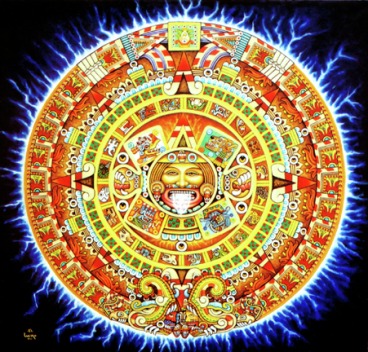
Original Oil Painting by Stevon Lucero Purchase Painting [email protected]
From, "The Calendar Stone" pg. 131......
"There is a mighty carved rock which is hanging in the National Museum of Mexico City. It was cut from porphyry, a volcanic stone which takes a high polish. This boulder is eleven feet across, three feet thick and even in its present state of mutilation, it weighs twenty-four tons. For many years after its discovery in the 18th Century it was thought to be Aztec and was called the Aztec Calendar Stone. Now scientists who have studied the calendars of Mexico realize that it is far beyond the comprehension of the Aztecs and so it is moving backward in time to the age of Tula and the Toltec Empire. The Aztecs had but a fifty-two year ritualistic calendar which is but a degenerate copy of the Toltec masterpiece of astronomical observation. In more ways than that of the calendar did the Aztecs throw the learning of Mexican civilizations back a thousand years. The Aztecs were the first conquerors to burn the ancient books and what survived the holocaust of the Aztecs were consumed by the Spanish."
"The Toltec Calendar Stone, having been taken from ravaged Tula first by the Chichimecas and then the Aztecs, was placed in the Aztec temple in Tenoch-titlan (Mexico City) so that the carved face stood outward where the people could see it. If they had fully understood what they were doing, they might not have done so. As it was , the people watched with ever-increasing apprehension the approach of the Time of Warning, which was the uppermost glyph, apparently a large aloe like the maguey plant (the sacred plant of the Aztecs), and about it as well as the container which held it were thirteen circles representing stars." ***
"As the time approached, near panic took place in all the land, so the Emperor, Mocte-zoma, had a new, smaller calendar stone made without a date of warning and buried the original deeply under the mud of the streets. Thus he thought to banish the threat to his throne and empire predicted so long before. It becomes increasingly evident that if the Aztecs had understood this calendar and its predictions, they would not have placed it in their main temple in the first place. Nevertheless, the people had not forgotten the Toltec Calendar Stone and when the first two centuries of the Conquest had passed, the Calendar Stone was again dug up and returned to its present place of honor."
"There is another idea expressed by Leon Y. Gama who saw the "Dark Rock" when it was first uncovered. Noting that the circle of carving does not exactly correspond to the square, he theorized that there was another "cycle" or companion piece. Probably this was the earlier "First Cycle" or the time following the Conquest, which would include the present? Were there more cycles than these? Bancroft, writing about a century after Gama, notes that no systematic search for ancient monuments such as these two mentioned, i.e. the Toltec Calendar Stone and the Altar of the Gladiators has ever been made. Furthermore, some sculptured blocks of the greatest scientific value have actually been seen while excavating for large buildings, but they have again been covered up and allowed to remain undisturbed under the pavements and public parks of a great modern metropolis. Incidentally, speaking of the Toltec Calendar Stone, Cortez arrived in the year Te-Tec-Patl as prophesied so long before in Tula by the Prophet."
***See 13 Stars Section
From, "The Legend of Colula" pg. 140.....
"Colula was called the Sacred City, for it was towered with many temples; as many as there were days in the Sun Year.
This was the Second City of Mighty Tollan, and greatly beloved was the Plumed Serpent, the Fair God of Wind and Water. Here Kate-Zahl came and constructed His greatest temple, the mighty pyramid of Quetzal-Coatl, with a greater base than Egypt's Cheops. There is a legend that it was begun by Xelhua the Thunderer after the flood of the Destruction however, it was finished by the Healer. Legends say it was fashioned of stone blocks, but Kate-Zahl covered it's sides with metal, gold and jewel encrusted until it shimmered in exquisite beauty. When the sunlight fell upon it, the glow was as from a thousand million mirrors.
"Like Tula, here too were the Toltec Parkways, wire-netted and filled with feathered singers; here too the vast maze of markets and the wide white city of the people. In the Great Temple the Plumed Serpent fashioned the Hall of the Four Directions. To the east was the golden room of the Sunrise; to the north the crimson of the flame-curtains which drop down from the skies in winter; to the west the blue of the Sunset Ocean mosaiced in turquoise and emerald with the bluish iridescence of the Xiuhtotl; while in the south, for the snows of the Far Lands, this room was finished in pearl and silver with the frost-like beauty of delicate feathers.
"Gone today is its ancient beauty. The Aztecs, when they came to power, did not bow to Quetzal-Coatl. They did not touch His Pyramid, but they committed the subtle heresy of killing men on the sacred altars to fend off the time of retribution. They could not forget His predictions and with blood they tried to woo Him. With fear and awe they looked on His Temple."
"This was not true of the Spanish. The bloodiest battle of all Meshico was fought over the Sacred City. From tier to tier up the Great Pyramid the battle was fought and when the Spanish finally reached the summit and had killed all the defenders, they were amazed to see a statue worked in the pale marble of a Christ-like man in a flowing mantle standing with outstretched arms to greet them. Furious at what they considered mockery they set upon the statue with their bloody hatchets, smashing it into a glittering rock pile. Then they turned to plundering the Temple. First they tried to destroy the Pyramid as they had the statue. With whips they drove the suffering people and told them to tear down the "Sacred Mountain", but the people would rather be killed than deface the old shrine. So the Spanish had to be contented with making their slaves carry up much mud to pour over the monument. The other temples were turned into churches, but the people ignored them."
"Very surprising to the conquerors was the way of the people. Even in the rain they trudged up the Great Hill, kneeling and weeping upon the summit. Seeing this odd veneration, the Spanish constructed a church on the summit and placed therein a statue of the Virgin, calling it the Chapel of Healing, on the spot where once stood an ancient altar.
So today the people stream upward laying gifts before the Pale Virgin and as they cross themselves with an ancient symbol, some think but of the moment, but there are some whose thoughts move backward to a day when the Plumed Serpent stood here and gently to their gathers pronounced His blessing."
"(Legend from Sedillio, Bancroft and Mayans.)"
